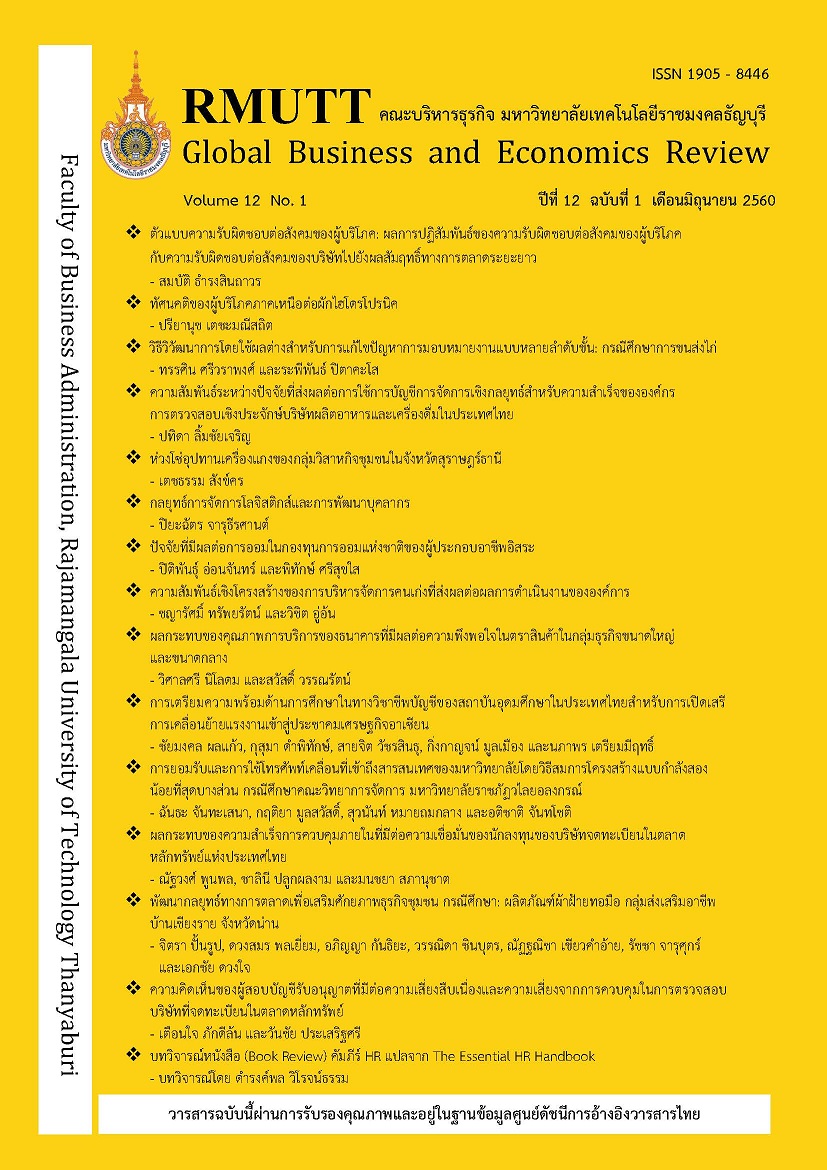THE DEVELOPMENT OF MARKETING STRATEGY FOR PROMOTING THE POTENTIAL BUSINESS COMMUNITY: A CASE STUDY OF COTTON HAND WEAVING PRODUCTS GROUPS AT CHIANG RAI VILLAGE, NAN PROVINCE
Keywords:
Cotton Hand Weaving Products, Marketing Strategy, Marketing EnvironmentAbstract
The study on “The development of marketing strategy for promoting the potential business community, case study: the cotton hand weaving products groups at chiang rai village, Nan province” was conducted by using samples comprised 23 person. The instrument was a rating scale questionnaire (in part 1) and interview (in part 2), to obtain the data were analyzed by means, standard deviation, and percentage. The results were presented in two parts of study as follows: Part one was explanted on general information of farmer who produced the cotton hand weaving products in the Chiang Rai village. The result shows that most of the farmers were females (95%) aged between 51 to 60 years old (43%) with married status (100%). Most of them were primary education (65%) and the average monthly income between 5,000 to 10,000 Baht/Month (100%). The popular product were pa-sin (fabric xian) (31.94%) and pa-hom (blankets) (27.78%), respectively. The business and commercial of the cotton hand weaving production in each farmer were conducted manufacturers and wholesalers with themselves. Part two was explained on general information about the marketing environment of the cotton hand weaving products in the Chiang Rai village. The result shows that this production were reduced due to increasing of competitor in the part of the cotton hand weaving production as well as current economic situation in thailand. For marketing environment include strengths, weaknesses, opportunities and threats of the cotton hand weaving products, The result shows that the cotton hand weaving products had strengths such as sponsored by the academy in the area, skilled workers and local knowledge while the weaknesses of goods were depended on imported raw materials, lack of modern technology, designer, as well as knowledge skill. For marketing strategy of the cotton hand weaving products at the current, the result shows that the marketing effectiveness of farmer are still needing help from the main target market, Phufa Pattana Center. In this study, the result found that the development of a marketing strategy as follows: 1) should develop a model of the product, a unique group and distinguished. 2) Product price should be set at a higher price to allow consumers to compare with other product. 3) product distribution should also add a variety of distribution channels that customers can easily access.
References
จิรายุ อิศรางกูร ณ อยุธยา. (2551). "คำปรารภ" ในคำพอ่สอนประมวลพระบรมราโชวาทและพระราชดำรัสเกี่ยวกับเศรษฐกิจพอเพียง. กรุงเทพฯ: มูลนิธิพระดาบส.
ธนาคารกสิกรไทย. (2554). ถนนสู่ AEC เพื่อ SMEs ไทย. สืบค้นจาก http://www.ksmecare.com/ Fileupload/Editor/DocumentUpload/Webcontent/ AEC_SMEs_TH_401.pdf
ลักขณา ธนาวรรณกิจ. (2540). ความพึงพอใจที่มีต่อผลิตภัณฑ์ผ้าจกจังหวัดราชบุรี. (วิทยานิพนธ์ปริญญา มหาบัณฑิต, มหาวิทยาลัยเกษตรศาสตร์).
สุนันทา ตั้งสถิต. (2546). แนวทางการพัฒนาตลาดผ้าหมี่ขิดของหมู่บ้านนาข่า อำเภอเมือง จังหวัดอุดรธานี. (วิทยานิพนธ์ปริญญามหาบัณฑิต, มหาวิทยาลัยมหาสารคาม).
สุเมธ ตันติเวชกุล. (2552). เศรษฐกิจพอเพียง ทางเลือก... ทางรอด. ใน เปี่ยมศักดิ์ คุณากรประทีป (บรรณาธิการ). ผ่าอนาคตประเทศไทย (น. 55). กรุงเทพฯ: ฐานการพิมพ์.
Apiwan, P. (2004). Factors Influencing Buying One Tambon One Product in Lopburi Province. (Master’s Thesis, Kasetsart University, Bangkok, Thailand).
Isherwood, K. (2000). Mineral Fertilizer Distribution and the Environment. Retrived from http://globalpnetwork.net/sites/default/files/IFA-UNEP%20(2000)%20Mineral% 20Fertilizer%20Distribution%20and%20the%20Environment.pdf
Kanchanarat, S. & Sangchai, N. (2016). The research and development of natural color batik product in community: case study in Namo Batik Group, Nakhon Si Thammarat, Thailand. International Journal of the Arts in Society, 4, 89-96.
Mankiw, N. G. (2004). Principles of Economics (3rd ed.). Mason, Ohio: Thomson/SouthWestern.
Napompech, K., Taphontong, S., & Aksornkitti, N. (2006). Marketing strategy for hand woven cotton. In Proceedings of 44th Kasetsart University Annual Conference: AgroIndustry, Economics and Business Administration. (pp.739-747). Bangkok: Kasetsart University.
Jaworski, B. J., & Kohli, A. K. (1993). Market orientation: antecedents and consequences. Journal of Marketing, 57, 53–70.
Kotler, P. (2000). Marketing management: analyzing consumer marketing and buyer behavior (The Millennium). New Jersey: Prentice Hall.
Kotler, P., & Armstrong, G. (1999). Principles of marketing (8th ed.). Upper Saddle River, New Jersey: Prentice-Hall.
Slater, S. F., & Narver, J. C. (1994). Does competitive environment moderate the market orientation–performance relationship?. Journal of Marketing, 58, 46–55.
Taphontong, S., Napompech, K. & Kukuanratanachai, S. (2004). Cost and Returns of Brocaded Silk Production from Ban Thasawang, Surin Province. In Proceedings of the 1st KMITL International Conference on Integration of Science & Technology for Sustainable Development (pp.244-247). Bangkok, Thailand: King Mongkut's Institute of Technology Ladkrabang.
Downloads
Published
How to Cite
Issue
Section
License
The articles published in this journal are the intellectual property of their respective authors.
The views and opinions expressed in each article are solely those of the individual authors and do not reflect the positions of Rajamangala University of Technology Thanyaburi or any of its faculty members. All components and content of each article are the sole responsibility of the respective authors. In the event of any errors, the authors shall bear full responsibility for their own work.








